CHAPTER 6
Jealousy and Concern for One’s Relationship
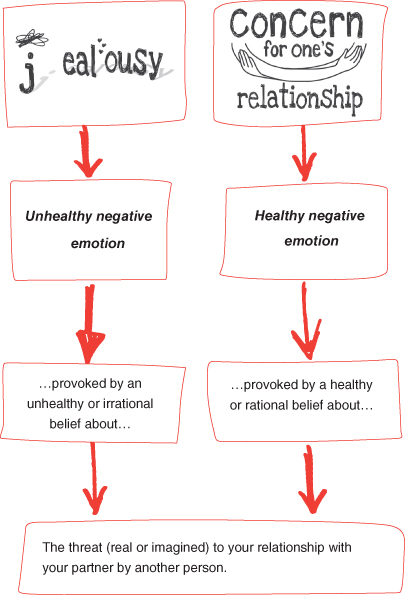
Jealousy, in effect, involves three people so there is a triangular relationship and it is a defining characteristic of jealousy: the threat from someone else to your relationship with your partner. The words jealousy and envy are often mixed up. Envy is about someone possessing something or even someone YOU desire. In this chapter we will be looking at some of the most common triggers for jealousy.
Jealousy
Jealousy is a highly destructive emotion. It can lead to aggression and violence and sadly even loss of life. ‘Crimes of passion’ are, on the whole, fuelled by jealousy. Jealousy can trigger extreme anger and hostility when rigid unhealthy beliefs are held demanding that the other person MUST love only them forever.
Jealousy contaminates relationships like a virus. When you feel jealous, you tend to behave in a possessive manner, looking and finding signs of infidelity (or of love interest) by your partner. It is destructive because the pain and misery is not just felt by the sufferer of jealousy but by the partner too. If you feel jealous you tend to monitor and check your partner; checking text messages, emails, letters, aftershave/perfume, underwear, questioning your partner and so on. A lot of the time your mind is preoccupied with thoughts of infidelity, wondering if your partner is committing it or thinking about it. With the constant vigilance over your partner’s behaviour, it is more than probable that you are also experiencing intense anxiety for much of the time. Even when you are in the company of your partner the vigilance is apparent, as you look for signs of the threat when out socialising together. You may remain preoccupied with it mentally even when you get home or you may start quizzing or accusing your partner.
When you experience jealousy it often tends to be accompanied by other unhealthy negative emotions of anxiety, anger, and self pity depression. If you experience these emotions alongside your jealous feelings then please refer to the chapters on anxiety (1), depression (2) and anger (3) to work through such problems too.
The following are typical jealousy provoking unhealthy beliefs:
- ‘If my husband looks at another woman, which he must not do, it means that he finds her more attractive than me. This must not happen, but if it does it proves that I am worthless.’
- ‘I absolutely have to know that my partner is interested in me and only me forever; the thought of my partner becoming interested in someone is unbearable and awful.’
- ‘My partner must only find me attractive and must not leave me otherwise it proves I’m worthless.’
- ‘My partner must only love me and never leave, otherwise he and the other person are worthless and bad people.’
- ‘My partner is allowed to find other people attractive, but he/she must find me more attractive than anyone else otherwise I’m inadequate and not good enough.’
- ‘I must be the only person my partner has ever been in love with; I can’t bear that I might not be.’
If you experience jealousy you may hold a belief that you can only feel ‘worthwhile’ if you are the centre and object of your partner’s love interest. This means that your worth is dependent on your partner’s thoughts, feelings and behaviour towards you. Unfortunately, this is out of your control and it is important to care but not so that your life and worth depend on it.
Common Jealousy Triggers
The following are common themes of jealousy – the list is not exhaustive. Tick the boxes that you think apply to you.
| Tick the box to identify your jealousy triggers |
 Seeing your partner pay attention to someone
else. Seeing your partner pay attention to someone
else. |
 Imagining your partner is seeing someone
else. Imagining your partner is seeing someone
else. |
 Partner’s apparent lack of attention Partner’s apparent lack of attention |
 Partner not always at your side Partner not always at your side |
 Imagining your partner is with the other
person Imagining your partner is with the other
person |
 Imagining partner’s emotional attachment with other
person Imagining partner’s emotional attachment with other
person |
 Checking /evaluating self against other members of the
same sex Checking /evaluating self against other members of the
same sex |
 Negative evaluation against other members of the same
sex Negative evaluation against other members of the same
sex |
 Imagining your partner is about to leave you for
someone else Imagining your partner is about to leave you for
someone else |
 Hearing your partner make positive comments about
someone else Hearing your partner make positive comments about
someone else |
 Seeing your partner look at someone else Seeing your partner look at someone else |
 Seeing your partner talk to someone Seeing your partner talk to someone |
 Your partner’s ex Your partner’s ex |
 Your partner’s past loves Your partner’s past loves |
 Your partner’s friendship/s Your partner’s friendship/s |
 Your partner’s work colleague/s Your partner’s work colleague/s |
 Other (write your own reason) Other (write your own reason) |
Am I Jealous or Concerned for my Relationship?
At the heart of your jealousy are unhealthy rigid beliefs about a threat to your relationship with your partner from another person.
Such unhealthy beliefs not only provoke jealousy but they have a consequence on how you think (cognitive consequences), and what you feel like doing (action tendencies).
When you feel jealous, for example, your thoughts may be preoccupied with ‘my partner will leave for someone else’ and you may then seek constant assurance and reassurance.
Look through the illustrations for the cognitive consequences and action tendencies and work out if you are jealous or concerned for your relationship. It is important to put yourself in the trigger situation when you feel or felt jealous. It is easy to think that you don’t have unhealthy rigid beliefs when you are not triggered or when you are away from the threat, so just imagine yourself in the frying pan, so to speak, and then work out if you are jealous or concerned for your relationship.
Cognitive Consequences
Jealousy
You tend to see a threat to your relationship when none exists.
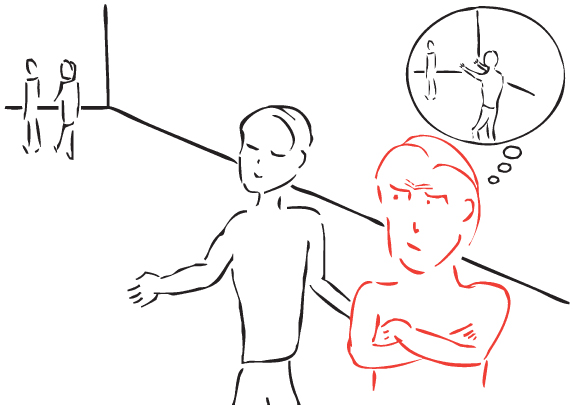
Cognitive Consequences
Concern for One’s Relationship
You tend not to see a threat to your relationship when none exists.
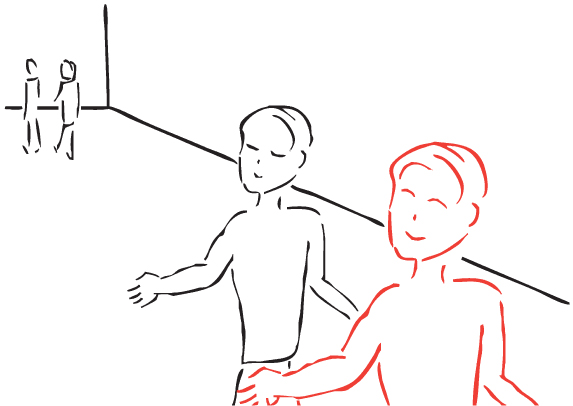
Cognitive Consequences
Jealousy
You think the loss of your relationship is imminent.

Cognitive Consequences
Concern for One’s Relationship
You do not think the loss of your relationship is imminent.

Cognitive Consequences
Jealousy
You tend to misconstrue your partner’s ordinary conversations with another man or woman as having a romantic or sexual connotation.

Cognitive Consequences
Concern for One’s Relationship
You do not misconstrue your partner’s ordinary conversations with another man or woman as having a romantic or sexual connotation.

Cognitive Consequences
Jealousy
You construct visual images in your mind of your partner’s infidelity.

Cognitive Consequences
Concern for One’s Relationship
You do not construct visual images of your partner’s infidelity.

Cognitive Consequences
Jealousy
If your partner admits to finding another person attractive you believe that the other is seen as more attractive than you and your partner will leave you for the other person.

Cognitive Consequences
Concern for One’s Relationship
You accept your partner will find other people attractive but you do not see it as a threat.

Action/Action Tendencies
Jealousy
You seek constant reassurance that you are loved.

Action/Action Tendencies
Concern for One’s Relationship
You allow your partner to express their love without seeking reassurance.

Action/Action Tendencies
Jealousy
You monitor the reactions and feelings of your partner.

Action/Action Tendencies
Concern for One’s Relationship
You allow your partner freedom without monitoring his or her feelings/actions and whereabouts.

Action/Action Tendencies
Jealousy
You search for evidence that your partner is with someone else.

Action/Action Tendencies
Concern for One’s Relationship
You allow your partner to show natural interest in other people without setting tests.

Action/Action Tendencies
Jealousy
You attempt to restrict the movements or activities of your partner.

Action/Action Tendencies
Concern for One’s Relationship
You do not restrict the movements or activities of your partner.

Action/Action Tendencies
Jealousy
You set tests which your partner has to pass.
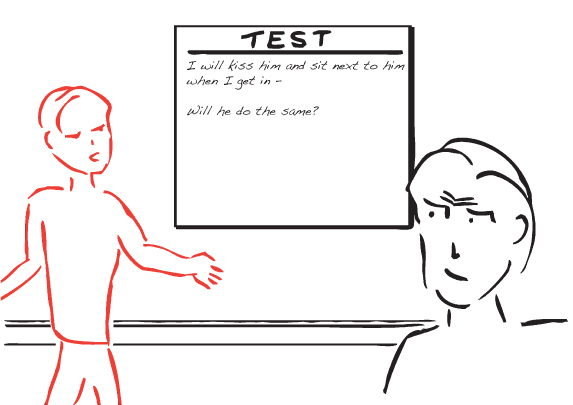
Action/Action Tendencies
Concern for One’s Relationship
You do not set tests.
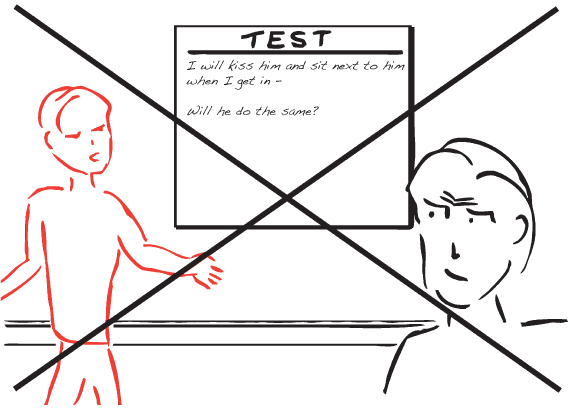
Action/Action Tendencies
Jealousy
You retaliate for your partner’s ‘presumed’ infidelity.

Action/Action Tendencies
Concern for One’s Relationship
You do not retaliate for your partner’s ‘presumed’ infidelity.
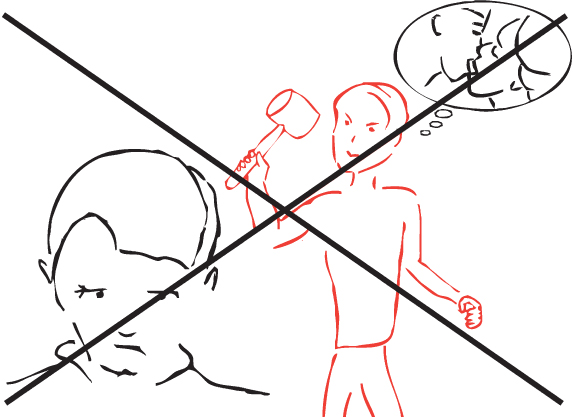
Action/Action Tendencies
Jealousy
You sulk.
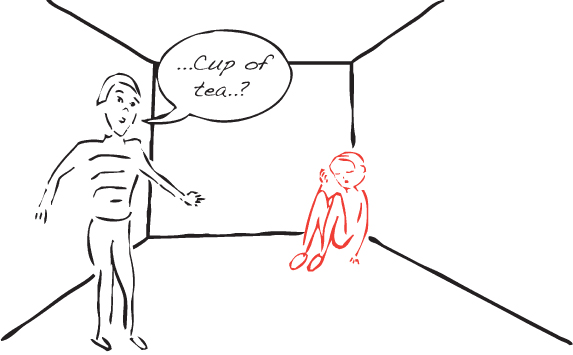
Action/Action Tendencies
Concern for One’s Relationship
You don’t sulk.
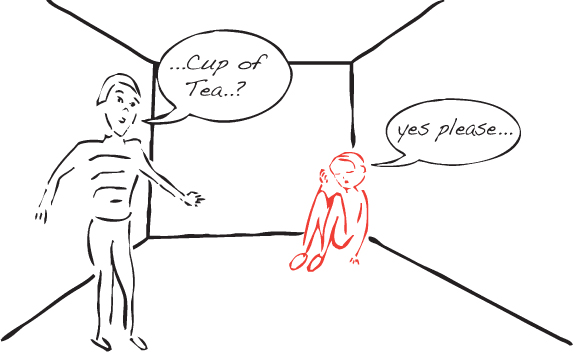
Now …
General Change or Philosophical Change for you?
General Change

Philosophical Change
Remember to take your time if you are choosing this route, as Philosophical Change is about changing your unhealthy beliefs over the long term.
Remember, jealousy is provoked by unhealthy beliefs about a threat to your relationship with your partner from another person. Unhealthy beliefs are made up of absolutist rigid beliefs in the form of a MUST, HAVE TO, NEED TO, GOT TO, ABSOLUTELY SHOULD, from which three further derivative beliefs come.

A rigid belief, at B, is a demand about the most jealousy provoking aspect of an event – it is either a demand for it to absolutely happen or absolutely not happen.
For example, if what you are jealous about is your partner’s previous relationships, then the rigid belief may be ‘My partner must love me more than anyone else’, or ‘I must be the only one he has ever loved’. If what you are most jealous about is your partner leaving you for someone else, then your rigid belief is ‘My partner must never leave me for someone else’. The consequence of not having the rigid belief met is any or a combination of the three derivative beliefs.
For example:

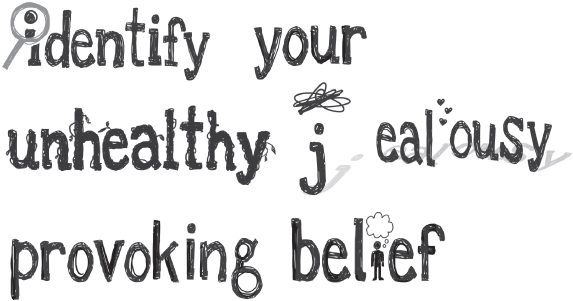
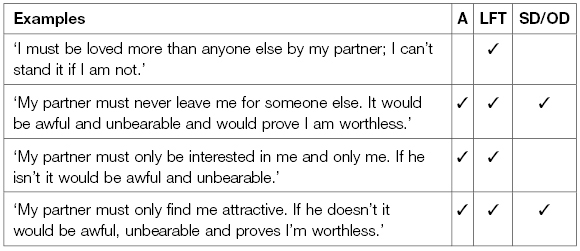
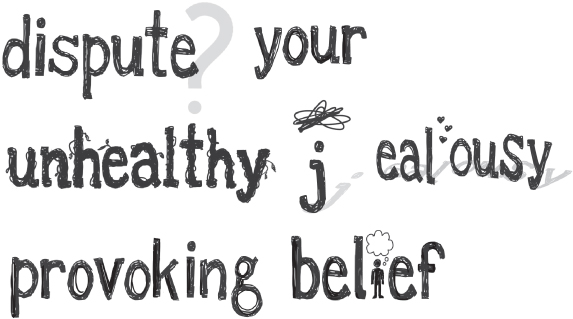
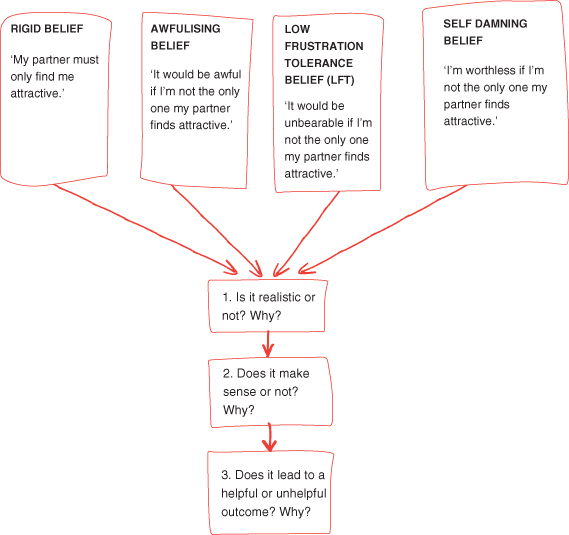


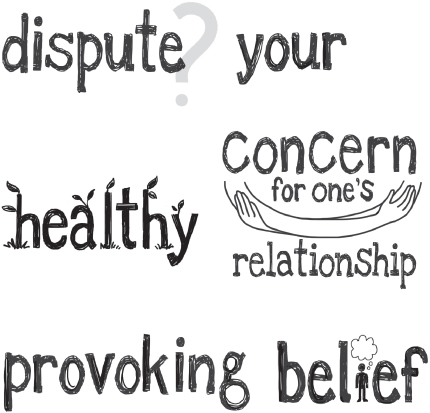

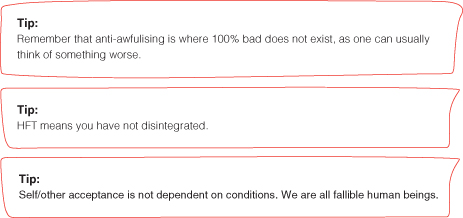
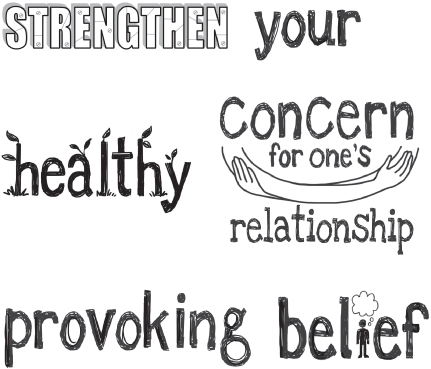

- Think and act in accordance with your healthy belief repeatedly and consistently in a forceful manner until eventually your emotional state changes from jealousy to concern.
- Remember your emotion of jealousy will change – the new way of thinking and the new actions you will implement will feel uncomfortable initially but this is completely natural. You are changing an old habit of unhealthy thinking and old habitual jealousy behaviours. It takes a few weeks of repetitions done consistently and forcefully.
- The behavioural goals you set for yourself need to be challenging but not overwhelming. If you overwhelm yourself then it defeats the object of the exercise.
- Start with imagining yourself thinking and acting in a healthy manner whilst being in the trigger situation until you think you are ready to challenge yourself in real life. For example, imagine yourself going out with your partner and not checking your partner’s behaviour towards others, but at some point you will need to take action and go out with your partner and practise your new healthy belief in the situation then continue until you achieve your desired goal.
- Repeat your healthy belief in your head daily and particularly when you are imagining yourself in the trigger situation. This mental rehearsal will help you to remember it when you deliberately face the trigger situation in real life.
- Once you achieve your desired goal, whatever it is, then you need to maintain the helpful thinking and actions. For example, your goal may be to go out with your partner and enjoy the experience without checking your partner’s behaviour towards others.
- Review how you did, each time you challenge yourself, and then work out what you can do differently or better the next time. Then do it. Do not demand perfection from yourself. The process of moving from jealousy to concern for your relationship is uncomfortable and uneven. Some days you will make bigger strides when you challenge yourself and other days you will make small strides or even take a step back. The important thing is to accept that this can happen and then bring your focus back to what you are doing and continue with it.
- Remember, you didn’t learn to drive a car, ride a bicycle or learn to read overnight, it takes repetition and focus and consistency.
Chapter 6 – Jealousy – Takeaway Tips
- Be mindful of suggestions like ‘how to make your partner addicted to you’. It’s not healthy or realistic.
- Accept the things that are within your control and the things that are not. You can control what you believe and what you do. You are not in control of what your partner thinks, feels, imagines or does.
- Accept yourself unconditionally. Your worth does not depend on anyone or on anything.
- Involve yourself in activities that you enjoy and build your own pleasure in life rather than making your life about your partner.